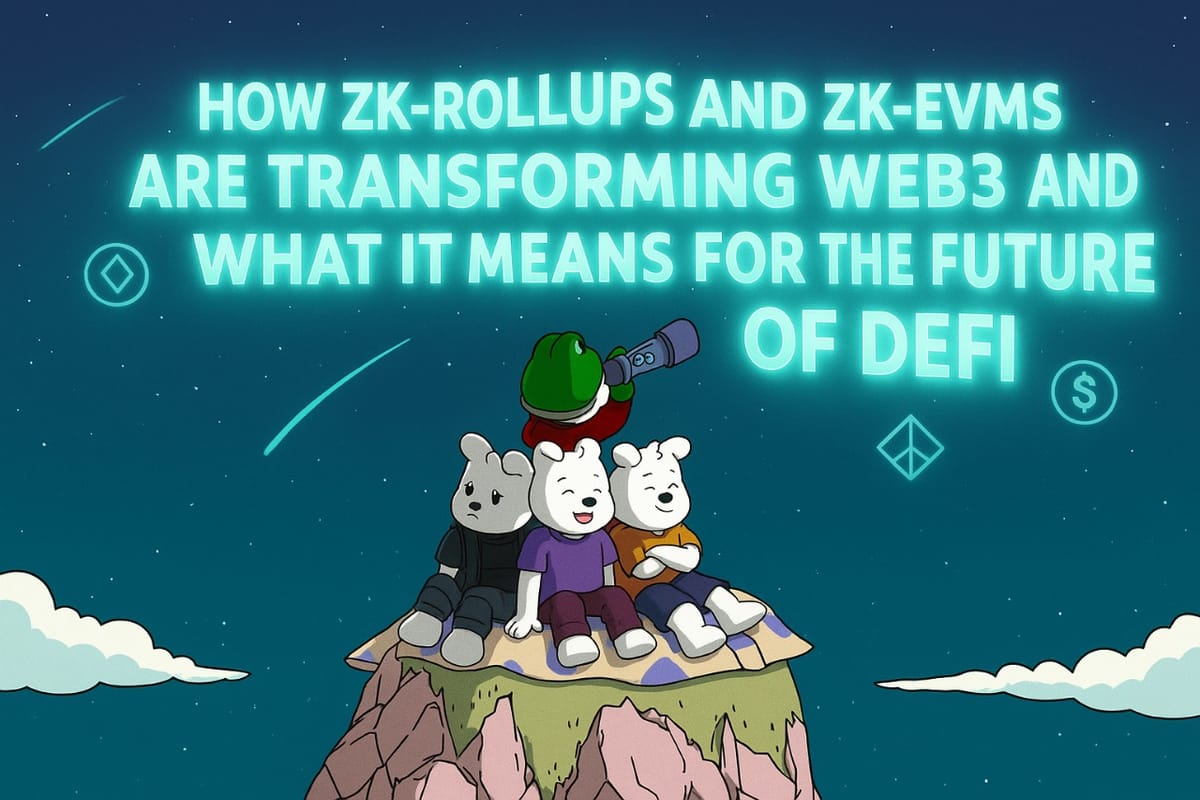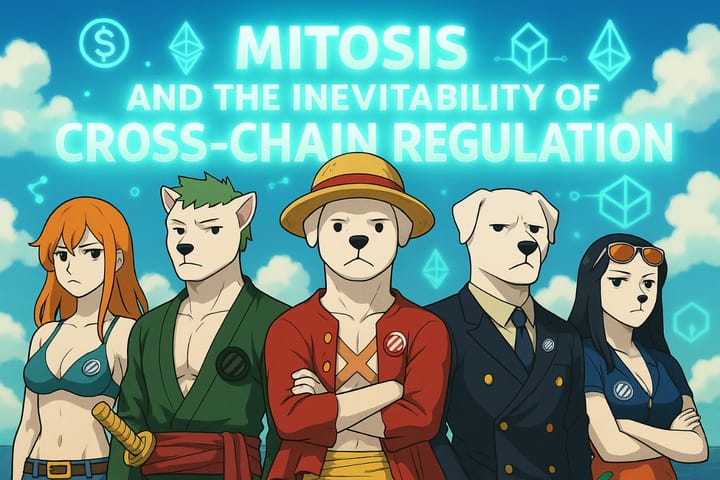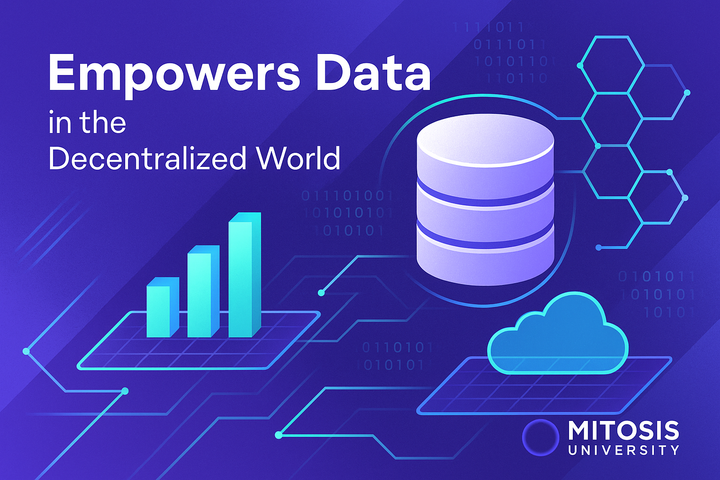The Zero-Knowledge Revolution: How ZK-Rollups and ZK-EVMs Are Transforming Web3 and What It Means for the Future of DeFi

1. Introduction: The Eternal Quest for Scale and Privacy in Blockchain
Since its inception, blockchain technology has held the promise of a decentralized, secure, and transparent future. However, as its popularity and user base have grown, its limitations have also become apparent, primarily the problems of scalability and privacy.
- Scalability: Major blockchains like Ethereum face limitations in the number of transactions they can process per second. This leads to high fees (gas) and slow confirmations during peak load periods, making many applications economically unviable for mass users.
- Privacy: Although transactions on public blockchains are pseudonymous (addresses are not directly linked to real identities), the entire history of operations is open for public scrutiny. This can be unacceptable for many commercial and private applications that require confidentiality.
The Web3 industry is tirelessly searching for solutions to these fundamental problems. And one of the most promising and technologically elegant answers has emerged in the form of Zero-Knowledge Proofs (ZKPs).
What Are Zero-Knowledge Proofs (ZK-Proofs)?
Imagine you want to prove to someone that you know a secret (e.g., the password to Ali Baba's cave) without revealing the secret itself. ZK-proofs allow you to do just that.
A ZK-Proof is a cryptographic method by which one party (the Prover) can prove to another party (the Verifier) that a certain statement is true, without revealing any information other than the fact that the statement is indeed true.
Key properties of ZKPs:
- Completeness: If the statement is true, an honest prover can always convince an honest verifier.
- Soundness: If the statement is false, no dishonest prover can convince an honest verifier of its truth (except with a very small probability).
- Zero-Knowledge: The verifier learns nothing other than the fact that the statement is true. No additional information about the prover's "secret" is revealed.
This seemingly magical concept has deep mathematical roots and opens up revolutionary possibilities for blockchain technologies.
ZK-Rollups: Scaling Ethereum Without Compromising Security
One of the main applications of ZK-proofs has been ZK-Rollups – Layer 2 solutions designed to scale Ethereum (and other blockchains).
How ZK-Rollups work (very simplified):
- Batch Processing: Many transactions are collected and processed off-chain on a special L2 node.
- Proof Generation: A single cryptographic ZK-proof is generated for this batch of transactions, confirming that all transactions in the batch were executed correctly and according to the rules.
- Publication to L1: This compact ZK-proof (along with minimally necessary transaction data) is published to the main Ethereum network (L1).
- Verification on L1: A smart contract on Ethereum verifies this ZK-proof. If it is valid, the entire batch of transactions is considered correctly executed and finalized with L1 security.
Advantages of ZK-Rollups:
- Significant Increase in Throughput: Off-chain transaction processing allows for thousands of TPS (transactions per second).
- Reduced Fees: Publishing a single proof for many transactions is significantly cheaper than publishing each transaction individually on L1.
- L1 Security: ZK-Rollups inherit the security of the main Ethereum network, as the correctness of all L2 transactions is cryptographically proven and verified on L1.
- Faster Finality (compared to Optimistic Rollups): Once the ZK-proof is verified on L1, transactions are considered final without a long waiting period for challenges, unlike in Optimistic Rollups.
What Will You Learn From This Article?
In this article, we will dive deeper into the world of ZK technologies and their transformative impact on Web3:
- We will examine the key differences between ZK-Rollups and their "competitors" – Optimistic Rollups.
- We will get acquainted with leading projects developing ZK solutions, such as Polygon zkEVM, zkSync, StarkNet, and their features.
- We will explore what new horizons ZK technologies open up for DeFi and GameFi.
- We will discuss how the growth of ZK ecosystems will affect the need for cross-chain solutions like Mitosis.
Get ready to learn how the mathematical "magic" of zero-knowledge proofs is building a more scalable, efficient, and potentially more private future for the decentralized internet.
2. The ZK Landscape: Players, Differences, and New Horizons
Understanding the basics of ZK-proofs and ZK-rollups is just the beginning. To appreciate their real impact, it's important to look at the key players in this field, their approaches, and the revolutionary opportunities they unlock for Web3.
ZK-Rollups vs. Optimistic Rollups: Key Differences
Before moving on to specific projects, it's important to understand the main difference between ZK-rollups and another popular L2 solution – Optimistic Rollups (e.g., Arbitrum, Optimism).
The main takeaway: ZK-rollups offer stronger security guarantees and faster finality at the cost of more complex technology. Optimistic Rollups are simpler to implement and often more EVM-compatible "out of the box" but have a long withdrawal period.
Leading ZK Projects: Who is Shaping the Future?
The ZK solutions market is actively developing, and several projects have already established themselves as leaders:
- zkSync (Matter Labs): One of the pioneers of ZK-rollups, aiming for full EVM compatibility with its zkSync Era development. Focuses on developer and user convenience, offering low fees and fast finality.
- StarkNet (StarkWare): Uses its proprietary STARK-proof technology (scalable and transparent). Offers high performance and flexibility but requires developers to learn a new programming language, Cairo (though work is being done on EVM compatibility).
- Polygon zkEVM: A solution from the Polygon team, aimed at full equivalence with the Ethereum Virtual Machine (EVM). This means developers can easily migrate their existing Ethereum applications to Polygon zkEVM with virtually no changes.
- Scroll: Another project striving for full EVM equivalence, paying close attention to sequencer decentralization (the node that orders transactions in L2).
- Loopring, Aztec Network: Projects using ZK technologies for specific tasks, such as DEX scaling (Loopring) or ensuring transaction privacy (Aztec).
Each of these projects has its unique approaches and trade-offs, but all are moving towards the common goal of making Ethereum (and Web3 in general) more scalable and efficient.
New Opportunities for DeFi and GameFi thanks to ZK
ZK technologies open up a range of exciting possibilities:
- For DeFi:
- Ultra-Cheap Transactions: Will allow DeFi protocols (DEXs, lending) to offer services with fees comparable to Web2, which is critical for mass adoption.
- Private DeFi Operations: Some ZK implementations (e.g., Aztec) allow transactions that hide amounts and addresses, which is important for financial privacy.
- More Complex Financial Products: Low fees and high performance can enable the creation of more sophisticated derivatives and other structured products.
- Improved Arbitrage and Market Making: The speed and low cost of transactions make these strategies more effective.
- For GameFi:
- Scalable Game Worlds: The ability to process thousands of game actions per second, creating truly interactive and complex online games on the blockchain.
- Protection Against Cheating: ZK-proofs can be used to verify the correctness of game actions without revealing the entire game logic.
- Privacy in Games: Hiding certain game states or assets.
- Cheap Minting and Transfer of In-Game NFTs.
ZK Ecosystems and the Need for Cross-Chain Solutions (Like Mitosis)
As numerous different ZK-rollups and ZK-EVMs grow and develop (each with its own ecosystem of dApps and liquidity), the problem of fragmentation will inevitably intensify, but on a new level – between these L2 networks.
- Users will want to move assets from one ZK-rollup to another, or between a ZK-rollup and the Ethereum mainnet, or even between a ZK-rollup on Ethereum and a completely different L1 blockchain.
- DeFi protocols built on one ZK solution may want to access liquidity or data from another ZK solution.
This is precisely where interoperability protocols like Mitosis become critically important. Mitosis, with its focus on:
- Secure liquidity movement (using EigenLayer AVS).
- Efficient liquidity management (via EOL).
- Simplifying the user experience for cross-chain operations.
The growth of ZK technologies does not eliminate, but rather increases the need for reliable and efficient cross-chain liquidity solutions.
Conclusion: ZK is the Future, Mitosis is Its Connecting Link
Zero-knowledge proof technologies are, without exaggeration, revolutionary for Web3. They offer a real path to solving scalability and privacy problems, opening doors for a new generation of decentralized applications.
Leading ZK projects are actively building this future, and as they mature, we will see an explosive growth of innovation in DeFi, GameFi, and other sectors. However, for this growth not to lead to a new wave of fragmentation, reliable interoperability protocols are necessary.
Mitosis, by preparing to provide liquidity and connectivity in the multichain world, including the rapidly growing ZK ecosystems, positions itself as an important infrastructure element for the next stage of Web3 development. ZK's magic builds more powerful "islands," and Mitosis builds bridges between them, creating a unified and thriving archipelago of a decentralized future.
Learn more about Mitosis:
- Explore details on the official website: https://www.mitosis.org/
- Follow announcements on Twitter: https://twitter.com/MitosisOrg
- Participate in discussions on Discord: https://discord.com/invite/mitosis
- Read articles and updates on Medium: https://medium.com/mitosisorg
- Blog: https://blog.mitosis.org/


Comments ()